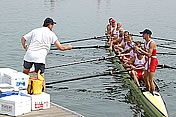World Rowing Championships
Report on World Rowing Championships
World rowing championships sees introduction of PWCs as rescue craft
At the "2005 FISA World Rowing Championships" held over an eight-day period from August 28 to September 4 at the Nagara River International Regatta Course in Kaizu city, Gifu Prefecture, Japan, personal watercraft were used as rescue and patrol craft with great effectiveness.
The “2005 FISA World Rowing Championships” is an Olympic-scale international event that drew over 1,400 participants and related personnel from 60 countries.
Until now this championship event has been held every year primarily in Europe. However, with the increasingly international spread of rowing as a sport, it was decided to hold the event in an Asian venue for the first time, with the Nagara River International Regatta Course chosen as the venue.
The competition’s qualifying rounds began on August 28 and the event, including the Adaptive classes for the physically challenged, continued successfully to the final conclusion on September 4.



Having noticed the effective use being made of PWCs in life saving and rescue operations in beach areas and lakes in places such as Hawaii and Australia in recent years, the event's organizing committee requested that the local fire department rescue specialists in the Nagara River vicinity and the PW Safety Association cooperate for a rescue operation team using PWCs for the event, making this the first time that PWCs have ever been used as rescue craft for the World Rowing Championships.
One precedent that led to the request for a PWC rescue team was the successful use of such a team at the 16th National High School Rowing Championships held at the Tenryugawa Hunagira Dam in Shizuoka Prefecture, Japan in March of this year. For the event, the Shizuoka Prefecture Rowing Association requested the co operation and support of a Yamaha Motor to conduct rescue operations using Yamaha WaveRunners. At that time, the Associations members were very impressed with the high level of mobility, maneuverability and speed of the PWCs, as well as the safety benefits involved in their [non-propeller] drive mechanism.
For the 2005 FISA World Rowing Championships this time, four PWCs were stationed around the race courses as rescue and patrol craft ready to respond in the case of capsizing or accidents during the official practice and race events. Making use of the special maneuverability and non-intrusive size of the PWCs, they were also used for up-close observation of the physical condition of the competitors as revealed in things like their face color and actions after finishing their races from a prescribed distance. In this way they were able to offer very specific back-up in the race operations. In the Adaptive competition (for competitors with leg, arm or visual disabilities) the PWC rescue team was able to help prevent accidents and create a safe and reassuring environment that enabled the competitors to concentrate on their racing by escorting the boats constantly, from the moment they left the piers until the boats were brought out of the water once again.
Furthermore, on top of being rescue-ready, the PWCs were used for course inspection before the races, and by stationing a PWC upstream and downstream from the race courses they were able to guard against litter or driftwood floating into the courses from downstream and to prevent other boats or fishermen from mistakenly entering the competition area by patrolling in a coordinated effort with a large Department of Transportation patrol boat.



These rescue and patrol activities this time were conducted as a cooperative effort involving special member companies of the PW Safety Association and volunteer efforts by members of the retail store association of the Chubu Regional Headquarters.
Among these participating members were former rowers who have participated in the World Rowing Championships, the Olympics and domestic competitions, members of the WRMA presently working for the spread of PWC rescue activities, as well as people involved in the development and testing of PWCs and PWC dealership owners and employees, all of whom worked together in a well coordinated effort.
During the competition, the PWC rescue craft actually proved their capability for speedy rescue work in incidents such as when a cox-and-four boat took on water and capsized, and when they rescued a European competitor suffering from sever hyperventilation after finishing a race and delivered him to a fire department paramedical team in an effort that prevented a possibly serious accident, and when two boats in the Adaptive competition that had become entangled in the course ropes were quickly freed and were able to return to the competition.



PWC rescue activities take advantage not only of the great maneuverability and speedy rescue potential of the PWC but also the safety element involved in the structural nature of the PWC with no underwater protrusions or exposed propeller that enable the driver to approach the victim and the victim to be approached with greater confidence.
In the rescue activities this time at the 2005 FISA World Rowing Championships the effectiveness of the PWC as a rescue craft was proven time and again.
The future is certain to see expanded efforts to train PWC rescue personnel and work out increasingly effective rescue systems so that PWCs will be used in a growing number of areas for rescue and patrol service in waters all around the world.